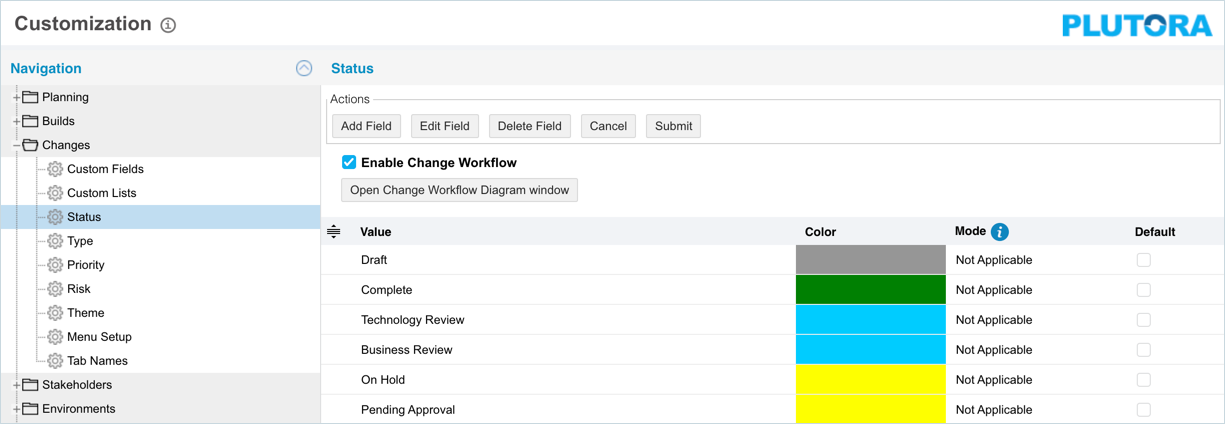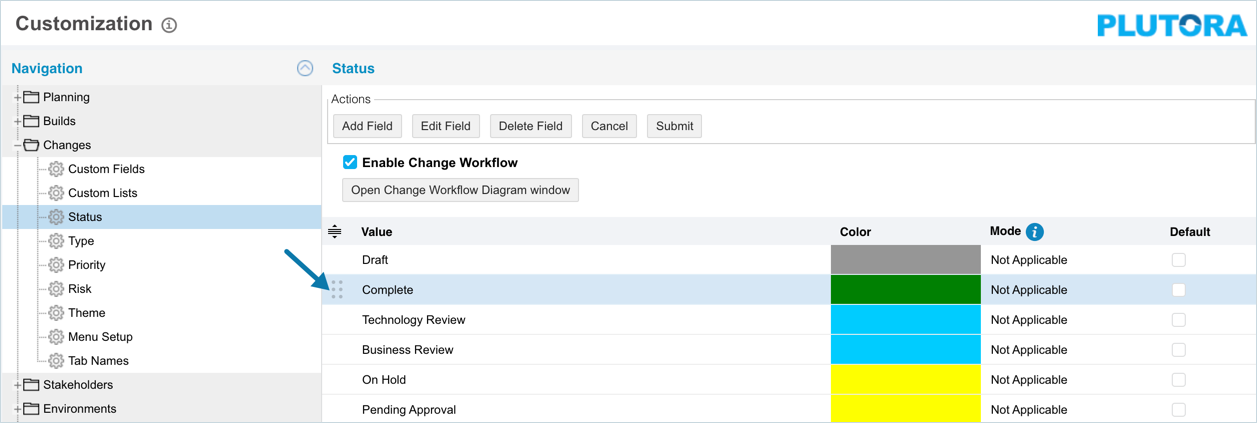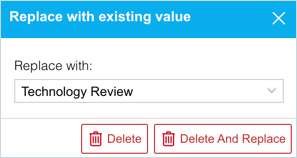Pre-requisite
To be able to add and customize Change Statuses, you must have ‘Access Customizations’ User Permission.
Navigation
Settings ![]() > Customization > Changes > Statuses
> Customization > Changes > Statuses
Add/Edit a Changes Status
To add or edit a Change Status:
- Navigate to the ‘Customization’ page and double click Changes.
- Click Status.
- Click
 .
. - The system adds a line on the grid for the new field. To edit an existing Status, search and click on the Status from the grid and then click
 .
. - Enter/edit the Status name in the Value column.
- Double click the Color column and select a color from the drop-down menu or enter a Hex value. This color appears on the ‘Changes Status’ label in the Change dialog (Release > Change).
- Click to select a Mode. For details on the Mode types, see Mode Types
- Select the Default checkbox to make the item appear by default in the drop-down menu.
- Click
 .
.
Your changes will be saved and a confirmation message will display.
Sort Changes Statuses
Sort Manually
Sorting Changes Statuses manually change their order in drop-down menus.
Your changes will be saved and a confirmation message will display.
Sort by Column Header
Sorting Changes Status by column header only changes their order on the ‘Customization’ page.
To sort alphabetically on the ‘Customization’ page by column header, click on the column header. ↑ or ↓ displays indicating the ascending or descending column sort.
Delete/Replace Changes Status
Deleting a Changes Status will not delete it from Change records. But it will no longer be available when adding or editing a Change.
While deleting, you can either select another status item that will replace the item to be deleted or simply delete the item from the list. Replacing a Changes Status will replace it in existing Change records.
To delete or replace a Changes Status:
- Navigate to the ‘Customization’ page and double click Changes.
- Click Statuses.
- Select the status that you want to delete or replace.
- Click
 .
. - The ‘Replace with existing value’ dialog displays.
- To replace: select the item that will replace the item to be deleted from Replace with. Then click
 .
. - To simply delete the item, click
 .
.
- To replace: select the item that will replace the item to be deleted from Replace with. Then click
The item is now deleted and the page navigates back to the Status page.
Enable Workflows
Workflows allow you to:
- Create a sequence of Changes Statuses for each Changes Type, from an initial status to an end status.
- Assign the privilege of setting that status to User Groups and User Roles (Permission Roles).
If workflows are turned off, all Changes Statuses will appear in the Changes Status drop-down menus in Change Manager. If workflows are turned on, only the Changes Statuses set for that Changes Type will appear.
To enable workflows:
- Navigate to the ‘Customization’ page and double click Changes.
- Click Status.
- Select the Enable Change Workflow checkbox.
- Click
 .
.
Your changes will be saved and a confirmation message will display.
For steps to add and customize Change Workflow, see Change Workflow.
More Information
Location of Change Status
To locate the Changes Status field:
- Go to Release > Change.
- Click to open a Change.
- The Changes Status field is located in the Details panel under the Change tab.
The color appears on the Change Status label in the Change pop up.
Change Status Mode Types
- Planning: For statuses relating to the initial stages of software development such as analysis, design, and estimation.
- Execution: For statuses relating to the actual development of software, such as development, testing, and review.
- Implementation: For statuses relating to the final stages of software development such as promoting software to Approved for Release, Deploying to Stage, and Production.
- Completed: For statuses relating to the successful delivery of software to production. It Makes the status an end state.
- Cancelled: For statuses relating to the software not being delivered to production. It Makes the status an end state.






